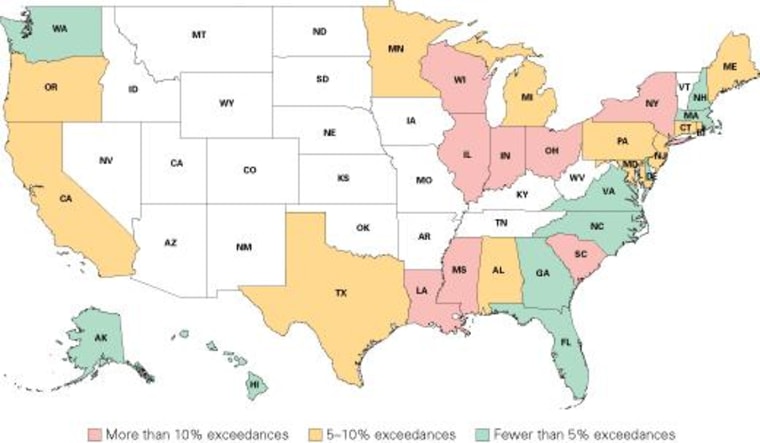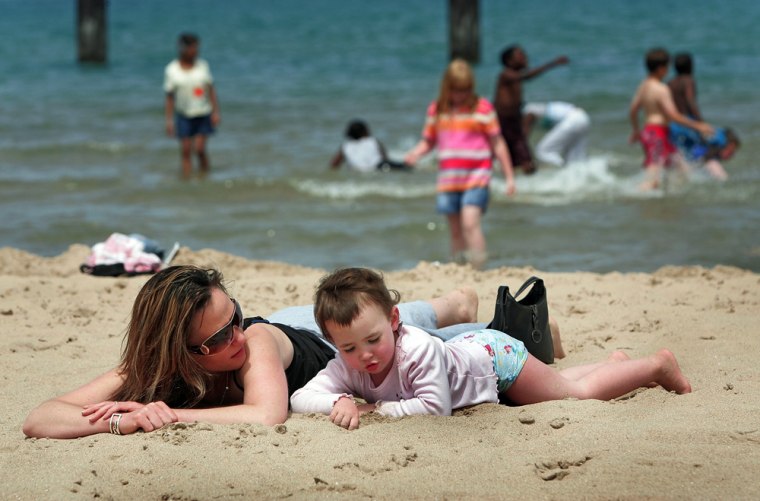U.S. beaches were in poor health last year, according to the Natural Resources Defense Council, which said Tuesday that pollution in 2007 led to the second-highest number of beach closings and advisory days in 18 years.
Human and animal fecal matter were to blame for much of the pollution, the council said in its annual report, leaving many beachgoers vulnerable to illnesses including gastroenteritis, dysentery and hepatitis.
The council also blamed outdated water quality standards and called for more rigorous monitoring of beaches.
Last year there were 22,571 beach closings and advisory days, the group said, citing data from the Environmental Protection Agency. The number was second only to 2006, when there were 25,643 such days.
From 2006 to 2007, the number of beach closings and advisory days due to sewage spills and overflows more than tripled to 4,097, the council said.
The largest known pollution source continues to be stormwater contamination, which caused more than 10,000 closing and advisory days in 2007, the council said. Stormwater dumps street pollution onto beaches and coastal waters without treatment whenever it rains.
Unknown sources of pollution caused more than 8,000 closing and advisory days, the NRDC said.
“Some families can’t enjoy their local beaches because they are polluted and kids are getting sick — largely because of human and animal waste in the water,” Nancy Stoner, director of the council's clean water project, said in a statement released with the report.
"Nationally, 7 percent of beachwater samples violated health standards, showing no improvement from 2006," the NRDC said. "In the Great Lakes, 15 percent of beachwater samples violated those standards — the highest level of contamination of any coastal region in the continental U.S."
Some closing and advisory day findings by region:
- Gulf Coast: The region had the biggest increase in closing and advisory days at 38 percent, partly because beaches in Louisiana and Mississippi were reopened and monitored for the first full beach season there since hurricanes Katrina and Rita struck in 2005.
- New York/New Jersey coast: Beaches here had the second-highest increase at 33 percent.
- Great Lakes: Closing and advisory days were up 1 percent.
- Hawaii: The state had the biggest drop in closing and advisory days at 36 percent due to abnormally high rainfall year in 2006.
Closing and advisory days were down 4 percent in the rest of the country between 2006 and 2007.
NRDC cites factors
The Natural Resources Defense Council said pollution factors include inadequate sewage and storm water systems as well as coastal development that removes natural buffers like wetlands, dunes and beach grass that help filter out pollution.

The conservation council said that national "beach water quality standards are more than 20 years old and rely on outdated science and monitoring methods that leave beachgoers vulnerable to a range of waterborne illnesses including gastroenteritis, dysentery, hepatitis, respiratory ailments and other serious health problems. For senior citizens, small children, and people with weak immune systems, the results can be fatal."
The council did not provide numbers on illnesses last year. But it cited a federal health study that tracked 62 waterborne disease outbreaks in 2003 and 2004 and said 2,698 people became ill during that time, resulting in 58 hospitalizations and one death.
"What this report means for families heading to the beach is they need to be careful and do a little homework," said Stoner. "Call your local public health authority and ask them if the beachwater is safe for swimming. If there is any doubt, or if the water smells bad or looks dirty, stay out of it."
The NRDC said beach protection bills pending in Congress would provide money for beachwater sampling and require use of faster testing methods.
Five-star rating guide
The 2008 report also came with a five-star rating guide for some of the most popular U.S. beaches. The criteria was based on indicators of beachwater quality, monitoring frequency and use of health standards to protect beachgoers.
Five stars went to:
- Five areas of Laguna Beach in Orange County, Calif: Blue Lagoon, Crescent Bay, Emerald Bay, Laguna Lido and Main Beach.
- Two areas at Bolsa Chica State Beach in Orange County.
- Two areas of Huntington City Beach in Orange County: Beach Hut and Jack's Snack Bar.
- Poipu Beach on Kauai, Hawaii.
- Salt Pond Beach Park on Kauai.
- Magic Island Beach in Honolulu.
- Wailea Beach Park on Maui, Hawaii.
- Beach 6 in Ocean City, Md.;
- Three beaches on Park Point near Duluth, Minn.
- Hampton Beach, N.H.
An interactive water quality map based on the rating guide is online at http://oceans.nrdc.org/beachgoers/map.
The full report is online at www.nrdc.org/beaches.
